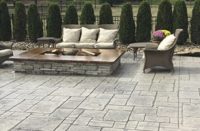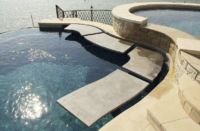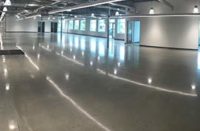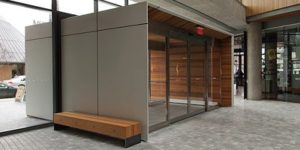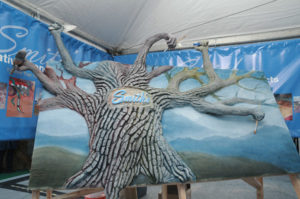If there’s one thing Vince Schrementi of Everlast Concrete has never been accused of, it’s being normal.
So when it came time to build his dream house, the Bomanite licensee in the Chicago area didn’t see any reason to change. It took him three years to build his concrete home, which his brother-in-law dubbed “The Flintstone House.”
“It actually looks like the house where the Flintstones meet the Jetsons,” Schrementi says. But at any rate, it got that nickname because there is a lot of concrete within those walls… and on the floors… and on the countertops… and the fireplace… and the stairs… and just about everywhere you look. Why, there’s even a concrete pond out back.
Of course, just like Schrementi, this isn’t your ordinary concrete. It’s safe to say it’s a concrete living environment unlike any other.

“I saw the house as an ongoing art project I could work on in my spare time, but my wife had other ideas,” he says with a laugh. “She actually wanted to live there.” So after three years of putzing around trying to get everything just so, he had to give in to some of her demands. That would explain the more traditional drywall treatment in the bedrooms, which are painted and carpeted like most of the other houses in the small town of Crete, Ill., where Schrementi was born and reared. In time, he confides, after he finishes the living room he’s been working on (and has been working on during the three years he, his wife and two young daughters have lived there), those will be his next canvas.
The years B.H. (before the house)
Like so many others now in the decorative concrete business, Schrementi first entered the trade (in 1979) as a concrete contractor, doing his fair share of foundation work. Somewhere along in the late ’80s, Jim Flamini, a fellow at a supply house where he did business, said his neighbor was interested in this colored and stamped concrete he had read about in a magazine. He was looking for a contractor.

“So I contacted the owner and told him I had never done a stamp job but if he would take a chance with me, all he had to pay for was the materials and the wages of the finisher,” he says. The owner took him up on the offer — “which was the deal of the century” — and Schrementi and his helper stamped a garage floor “that was every bit 400 to 500 square feet,” he says.
“We poured, colored and stamped with just four stamps,” he says. “That’s all we could afford. It was an unbelievable experience and the floor came out good. But if you ask me if I would ever do it again, I’d have to say ‘no way.’ Now I just shake my head and laugh that I did something that crazy, but luck was with us and it worked out.”

No one else in the area was doing that type of work, Schrementi says, and it looked like he had found his niche. Soon after, he traveled to the World of Concrete in Atlanta, where he bought four sets of stamps so he could expand his repertoire. On the way home, his plane was delayed and, to make a long story short, he met a seasoned Florida-based contractor originally from Illinois who offered to show him the ropes in the stamping business.
Two months later, Schrementi flew to West Palm Beach to visit his newfound friend, Pat Smith of Custom Stamped Concrete. He ended up staying 10 days and learning enough to successfully launch his own decorative concrete business. “We’re still great friends to this day,” he says.

Expanding the business
In 1994, Schrementi signed on as a licensee with Bomanite. “At that time, I thought I knew quite a bit about coloring and stamping concrete. I hadn’t gotten into doing stains yet,” he adds. “At the first technical workshop I went to with the Bomanite folks, I met contractors who had been stamping for 30 years. It was a very humbling experience. They had been stamping almost as long as I had been alive.” He soon realized he didn’t know as much as he thought he did.
Schrementi says he saw the relationship with the California-based company not only as a way to learn more about the business but also as a good opportunity to break into more commercial work. And the association has paid off. His client roster includes such notables as Crate and Barrel, Starbucks, Eddie Bauer and Harley-Davidson. The small-town contractor has done work at the US Cellular Field, home of the White Sox. He’s also done floors for the Chicago Bears’ Team Store, the Field Museum in Chicago and the small mammal and reptile house at the Lincoln Park Zoo, to name but a few.

He says that 90 percent of his work is in the Chicago area, but consulting gigs have taken him to such places as New York City, Austin, St. Louis, Cincinnati, Kansas City and Indianapolis.
Big city jobs aside, he says, when it comes down to his all-time favorite project, it’s a little closer to home. In fact, it is home. And he’s not alone with this partiality. The Flintstone House netted Everlast Concrete the 2003 Gold award for the Outstanding Bomanite Project Worldwide. And more recently, HGTV wants to feature the home on its new series, “Offbeat America.” Basically the new “Extreme Homes,” the show features atypical housing to awe the audience with the amazing architecture and creativity that abounds in this country.

Yabba dabba do
“When we broke ground on the house, I knew there were some different things I wanted to do with the finishes but I had no idea where I was going with them or where they would end up. It was kind of a ‘design as you go’ project,” Schrementi explains about the 4,000-square-foot home.
A lot of the home’s designs, he says, were inspired by pictures in National Geographic. One wall conjures up an aerial shot of rice paddies on a steep mountainside in Thailand. Another simulates a deep excavation where various layers of the Earth are exposed. Some images look like the desert; others like the moon or the landscapes of faraway planets. The fireplace looks like some out-of-this-world stone monolith.
 And then there are the whimsical touches. The curved stairway, which Schrementi calls “his spaghetti stairs,” have edges that look like twisted strands of linguini, thanks to the creative use of mop heads for texturing. A concrete handrail, being held in place by a group of stick people, is fashioned to resemble bone or ivory. Real leaves from a friend’s flower shop were used to imprint a bathroom vanity and sink. The multi-colored concrete countertop in the kitchen features a random-cut pattern soldered together.
And then there are the whimsical touches. The curved stairway, which Schrementi calls “his spaghetti stairs,” have edges that look like twisted strands of linguini, thanks to the creative use of mop heads for texturing. A concrete handrail, being held in place by a group of stick people, is fashioned to resemble bone or ivory. Real leaves from a friend’s flower shop were used to imprint a bathroom vanity and sink. The multi-colored concrete countertop in the kitchen features a random-cut pattern soldered together.
The ongoing project in the living room, which has required a scaffold for the past three years, involves scrap pieces of metal and glass fashioned together to create a sea of faces in an offbeat metal and concrete mosaic.
“Sculpturing walls with different textures is my favorite technique,” Schrementi says. “You can make them lumpy and bumpy,” he adds, unlike a floor, where flat and smooth are much-desired qualities.

The Flintstone House project wasn’t a walk in the park, Schrementi confides, and there were some times of high tension between him and his wife, Sara. It was hard for him to convey what exactly he was doing when he was trying to turn his concepts into tangible art forms. “It wasn’t like I could show her a picture,” he explains. But as he completed one section after the other, she became more comfortable with the whole thing. “She went from all these questions to a quiet acceptance,” he says. “The woman is a saint.”
Here is a video featuring Vince’s work that been created by Concrete Decor staff.
